
The Gnaphalieae are a tribe of flowering plants in the family Asteraceae. It is most closely related to the tribes Anthemideae, Astereae, and Calenduleae.

Rhodanthe, also known as sunray or pink paper daisy, is a genus of Australian plants in the tribe Gnaphalieae within the family Asteraceae.

Olearia, most commonly known as daisy-bush, is a genus of flowering plants belonging to the family Asteraceae, the largest of the flowering plant families in the world. Olearia are found in Australia, New Guinea and New Zealand. The genus includes herbaceous plants, shrubs and small trees. The latter are unusual among the Asteraceae and are called tree daisies in New Zealand. All bear the familiar daisy-like composite flowerheads in white, pink, mauve or purple.

Chrysocephalum, known by the common name everlastings for their long life as cut flowers, is a genus of flowering plants in the family Asteraceae. There are nine species, all of which were formerly classified under other genera.
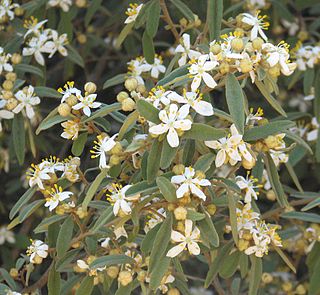
Asterolasia is a genus of seventeen species of erect or prostrate shrubs in the family Rutaceae, and is endemic to Australia. The leaves are simple and arranged alternately, the flowers arranged in umbel-like groups on the ends of branchlets or in leaf axils, usually with five sepals, five petals and ten to twenty-five stamens. There are seventeen species and they are found in all Australian mainland states but not in the Northern Territory.

Anthocercis, commonly known as tailflower, is a genus of shrubs which are endemic to southern temperate Australia with the center of distribution in the South West Botanical Province of Western Australia. All species of Anthocercis contain tropane alkaloids, and have occasionally caused poisoning in children or been suspected of poisoning stock. Anthocercis is known as the only Solanaceous plant known to produce resin compounds on glandular trichomes.
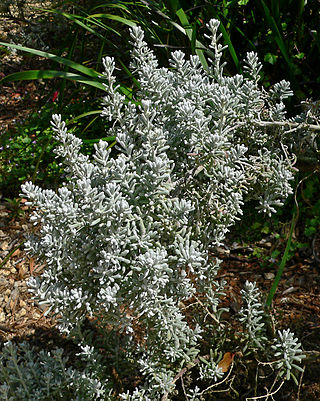
Maireana is a genus of around 57 species of perennial shrubs and herbs in the family Amaranthaceae which are endemic to Australia. Species in this genus were formerly classified within the genus Kochia. The genus was described in 1840 by the botanist, Moquin-Tandon and named to honour Joseph François Maire (1780-1867), an amateur botanist who befriended him during the author's first visit to Paris in 1834.
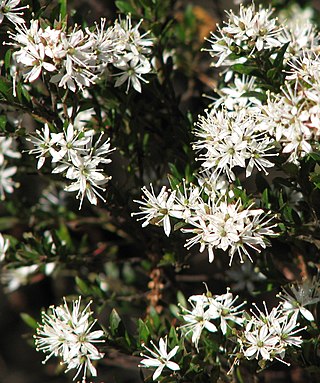
Leionema is a genus of more than 20 species of mostly small shrubs in the family Rutaceae, most of which are endemic to eastern Australia. Plants within this genus have scented foliage and clustered, star-shaped flowers which range in colour from cream to bright yellow. Prior to 1998, all species within this genus were included in the genus Phebalium.
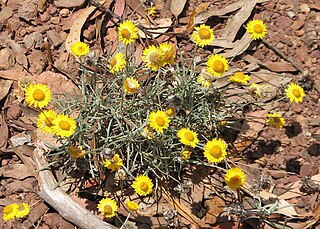
Leucochrysum is a genus of flowering plants in the tribe Gnaphalieae within the family Asteraceae, endemic to Australia.
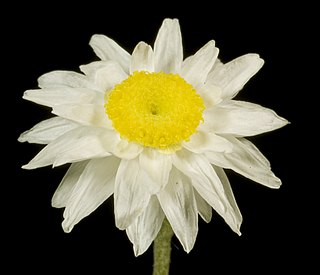
Hyalosperma is a genus of Australian flowering plants in the family Asteraceae.
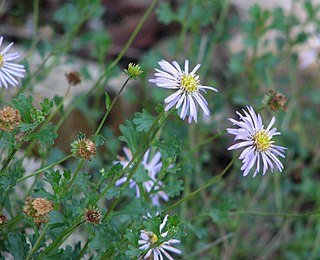
Calotis is a genus of herbs or small shrubs in the daisy family Asteraceae. Most of the species are native to Australia, while two occur in Asia.
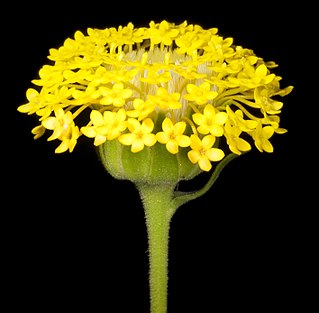
Podotheca is a genus of flowering plants in the tribe Gnaphalieae within the family Asteraceae. All species are endemic to Western Australia, except for Podotheca angustifolia which occurs across the south of Australia.
Leptorhynchos is a genus of annual or perennial herbs in the family Asteraceae. All species are endemic to Australia. These include:

Coronidium is a genus of flowering plants in the family Asteraceae. The genus is endemic to Australia.
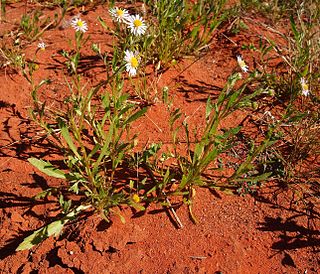
Vittadinia is a genus of Australian and New Zealand plants in the tribe Astereae within the family Asteraceae.
Minuria is a genus of annuals, perennials and dwarf shrubs in the tribe Astereae within the familyAsteraceae.

Wilkiea is a genus of dioecious trees and shrubs in the Mollinedieae tribe of the family Monimiaceae. They grow in Australia and New Guinea. Species mostly have toothed leaves with short leaf stems and many oil dots on the leaves. The genus appears to have an Australian or southern origin.

Pseudoweinmannia lachnocarpa is a rainforest tree of eastern Australia. Common names include rose marara, mararie, scrub rosewood and red carabeen. The species name lachnocarpa is from the Greek, referring to the "woolly fruit". The genus name refers to the similarity of another genus, Weinmannia, after the German eighteenth century pharmacist J.W. Weinmann.

Coronidium scorpioides, commonly known as the button everlasting, is a perennial herbaceous shrub in the family Asteraceae found in Australia. Previously known as Helichrysum scorpioides, it was placed in the newly described genus Coronidium in 2008.

Rhadinothamnus is a small genus of shrubs in the family Rutaceae. The genus, which is endemic to Western Australia, was formally described in 1971.


















